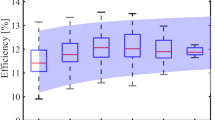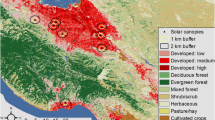Abstract
To study the likely effects of global warming on open-field vegetation, hexagonal arrays of infrared heaters are currently being used for low-stature (<1 m) plants in small (≤3 m) plots. To address larger ecosystem scales, herein we show that excellent uniformity of the warming can be achieved using nested hexagonal and rectangular arrays. Energy costs depend on the overall efficiency (useable infrared energy on the plot per electrical energy in), which varies with the radiometric efficiency (infrared radiation out per electrical energy in) of the individual heaters and with the geometric efficiency (fraction of thermal radiation that falls on useable plot area) associated with the arrangement of the heaters in an array. Overall efficiency would be about 26% at 4 m s−1 wind speed for a single hexagonal array over a 3-m-diameter plot and 67% for a 199-hexagon honeycomb array over a 100-m-diameter plot, thereby resulting in an economy of scale.









Similar content being viewed by others
References
Ainsworth EA, Beier C, Calfapietra C, Ceulemans R, Durand-Tardif M, Farquhar GD, Godbold DL, Hendrey GR, Hickler T, Kaduk J, Karnosky DF, Kimball BA, Körner C, Koornneef M, LaFarge T, Leakey ADB, Lewin KF, Long SP, Manderscheid RM, McNeil DL, Mies TA, Miglietta F, Morgan JA, Nagy J, Norby RJ, Norton RM, Percy KE, Rogers A, Soussana J-F, Stitt M, Weigel H-J, White JW (2008) Next generation of elevated [CO2] experiments with crops: a critical investment for feeding the future world. Plant Cell Environ 31:1317–1324
Allen RG, Walter IA, Elliott RL, Howell TA, Itenfisu D, Jensen ME, Snyder RL (2005) The ASCE standardized reference evapotranspiration equation. American Society of Civil Engineers, Reston
Bijoor NS, Czimczik CI, Pataki DE, Billings SA (2008) Effects of temperature and fertilization on nitrogen cycling and community composition of an urban lawn. Global Change Biol 14:2119–2131
Campbell GS (1977) An introduction to environmental biophysics. Springer, New York
Gebhart B (1961) Heat transfer. McGraw-Hill, New York
Ham JM (2005) Useful equations and tables in micrometeorology. In: Hatfield JL, Baker JM (eds) Micrometeorology in Agricultural Systems. American Society of Agronomy, Crop Science Society of Agronomy, and Soil Science Society of America, Madison, pp 533–560
Harte J, Torn MS, Chang F-R, Feifarek B, Kinzig A, Shaw R, Shen K (1995) Global warming and soil microclimate results from a meadow-warming experiment. Ecol Appl 5:132–150
Hendrey GR (1993) Free-air carbon dioxide enrichment for plant research in the field. Smoley, Boca Raton
Hendrey GR, Lewin KF, Kolber Z, Evans LS (1992) Controlled enrichment system for experimental fumigation of plants in the field with sulfur dioxide. J Air Waste Manag Assoc 42:1324–1327
Hendrey GR, Ellsworth DS, Lewin K, Nagy J (1999) A Free-Air CO2 Enrichment System (FACE) for exposing tall forest vegetation to elevated atmospheric CO2. Global Change Biol 5:293–309
Hovenden MJ, Miglietta F, Zaldei A, Vander Schoor JK, Wills KE, Newton PCD (2006) The TASFACE climate-change impacts experiment: design and performance of combined CO2 and temperature enhancement in a native Tasmanian grassland. Aust J Bot 54:1–10
Howell JR (2001) A catalog of radiation heat transfer configuration factors, 2nd edition. http://www.me.utexas.edu/∼howell/
Kimball BA (2005) Theory and performance of an infrared heater for ecosystem warming. Global Change Biol 11:2041–2056
Kimball BA (2011) Comment on the comment by Amthor et al. on “Appropriate experimental ecosystem warming methods” by Aronson and McNulty. Agr Forest Meteorol 151:420–424
Kimball BA, Conley MM (2009) Infrared heater arrays for warming field plots scaled up to five meters diameter. Agr Forest Meteorol 149:721–724
Kimball BA, Conley MM, Wang S, Lin X, Luo C, Morgan J, Smith D (2008) Infrared heater arrays for warming ecosystem field plots. Global Change Biol 14:309–320
Körner C, Asshoff R, Bignucolo O, Hättenschwiler S, Keel SG, Peláez-Riedl S, Pepin S, Siegwolf RTW, Zotz G (2005) Carbon flux and growth in mature deciduous forest trees exposed to elevated CO2. Science 309:1360–1362
Lewin KF, Nagy J, Nettles WR, Cooley DM, Rogers A (2009) Comparison of gas use efficiency and treatment uniformity in a forest ecosystem exposed to elevated [CO2] using pure and prediluted free-air CO2 enrichment technology. Global Change Biol 15:388–395
Luo C, Xu G, Chao Z, Wang S, Lin X, Hu Y, Zhang Z, Duan J, Cang X, Su A, Li Y, Zhao X, Du M, Tang Y, Kimball B (2010) Effect of warming and grazing on litter mass loss and temperature sensitivity of litter and dung mass loss on the Tibetan plateau. Global Change Biol 16:1606–1617
Mahrt L, Ek M (1984) The influence of atmospheric stability on potential evapotranspiration. J Clim Appl Meteorol 23:222–234
Miglietta F, Zaldei A, Peressotti A (2001) Free-air CO2 enrichment (FACE) of a poplar plantation: the POPFACE fumigation system. New Phytol 150:465–476
Monteith JL (1973) Principles of environmental physics. Edward Arnold, London
Nijs I, Kockelbergh F, Teughels H, Blum H, Hendrey G, Impens I (1996) Free air temperature increase (FATI): a new tool to study global warming effects on plants in the field. Plant Cell Environ 19:495–502
Okada M, Lieffering M, Nakamura M, Yoshimoto M, Kim M, Kobayashi K (2001) Free-air CO2 enrichment (FACE) using pure CO2 injection: system description. New Phytol 150:251–260
VanLoocke A, Bernacchi C, Twines TE (2010) The impacts of Miscanthus x giganteus production on the Midwest US hydrologic cycle. GCB Bioenergy 2:180–191
Wall GW, Kimball BA, White JW, Ottman MJ (2011) Gas exchange and water relations of spring wheat under full-season infrared warming. Global Change Biol 17:2113–2133
Acknowledgements
We appreciate the sharing of Bondeville, IL weather data by Andy VanLoocke from the Department of Atmospheric Sciences, University of Illinois, Urbana, IL, USA. This research was supported by the US Department of Agriculture, Agricultural Research Service and by the U.S. Department of Energy (DOE), Office of Science, Biological and Environmental Research (BER) program and by the US Department of Energy Office of Science contract No. DE-AC02-98CH10886 to Brookhaven National Laboratory. USDA and DOE are equal opportunity providers and employers.
Author information
Authors and Affiliations
Corresponding author
Rights and permissions
About this article
Cite this article
Kimball, B.A., Conley, M.M. & Lewin, K.F. Performance and energy costs associated with scaling infrared heater arrays for warming field plots from 1 to 100 m. Theor Appl Climatol 108, 247–265 (2012). https://doi.org/10.1007/s00704-011-0518-5
Received:
Accepted:
Published:
Issue Date:
DOI: https://doi.org/10.1007/s00704-011-0518-5




